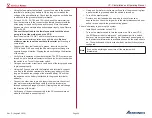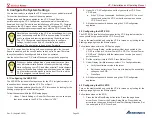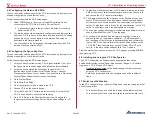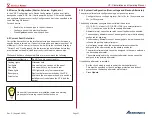
Page 68
VP-X Installation and Operating Manual
Rev. D (August 5, 2020)
10. VP-X System Operation
This section describes the operation of the VP-X. Additional details can be
found in the EFIS manual provided by the EFIS manufacturer.
10.1
Power On and Off
Turn ON the VP-X by turning on the aircraft master switch.
When turned on, the VP-X performs the following checks:
Internal data integrity checks
. If it fails the internal data integrity checks,
the system resets to its default values and the EFIS turns on to display the
specific fault. The switch settings, trim and flaps settings are cleared and do
not operate. The EFIS may be able to restore the settings to the VP-X. If this
failure occurs please contact VP tech support.
Trim and flap input checks
. If any of the trim or flap switch inputs are active
(i.e. a trim switch pressed) during startup, the trim circuit shows a fault. You
must clear the physical fault (either a stuck switch or shorted wire), then
cycle power to the system to clear the fault in the system.
General fault checking
. If any faults exist on the VP-X at power on, it will
automatically turn on the EFIS circuit so that the EFIS can display the fault.
Turn OFF the VP-X by turning off the master switch. Note that backup
circuits, if installed, must be turned off as well.
After turning off the VP-X, wait at least 5 seconds before
turning the system back on again.
The short delay will give the electronics time to discharge and
clear properly.
10.2 EFIS Electrical System Page
When the VP-X is configured to work with a supported EFIS, the EFIS
display includes an electrical system page. Each EFIS is different, but in
general the EFIS can:
•
Show a list of each of the power circuits, including trim and flap
• Show the status of each circuit, whether on or off or faulted (and type
of fault).
• Total current draw of all circuits
• View the current draw, in amps, of each circuit. The minimum
detectable amount is 100 mA (1/10 of an amp).
• Allow user to reset a faulted circuit.
• Show graphical electrical system diagram, including main bus
voltage and aux battery voltage.
• Show VP-X internal temperature
• Allow manual control of each individual circuit, including trim and
flaps.
10.3 Other VP-X functions
In addition to the Electrical System page, the following data is used by the
EFIS and displayed to the user:
•
Trim and flap position
•
Trim and flap in-motion indicator
• Pitch trim speed, as a percentage of maximum speed
• Wig wag active indicator
• VP-X system faults (see table at end of this document)
10.4
Turning electrical devices on and off
Devices can be turned on or off in one of several ways:
1. Using the switches wired to the switch inputs on the VP-X.
2. Using the backup switches, if installed.
3. Using the soft keys on the EFIS. This allows you to turn on and off
an individual device separately and independently from the switch it
is assigned to. Cycling the switch will reset the device back to switch
operation.
Only one alternator can be on at a time. If both are turned on, then the most
recent one to turn on stays on and the other one is turned off.
10.5
Trim and flap operation
The flaps can be operated by the flap switch or by the soft keys on the EFIS.
The flaps are configured to move in one of two ways:
1.
Only when the flap switch is pressed, or
2. Move to the next down position (and all the way up) with a
momentary press of the flap switch.




































